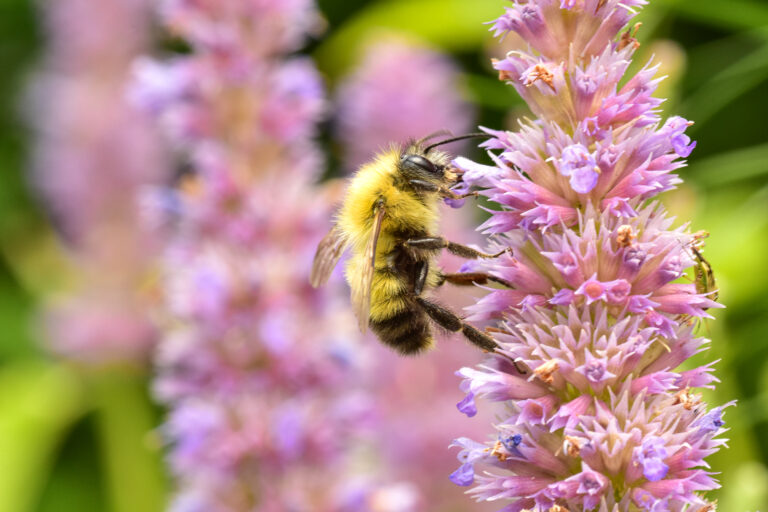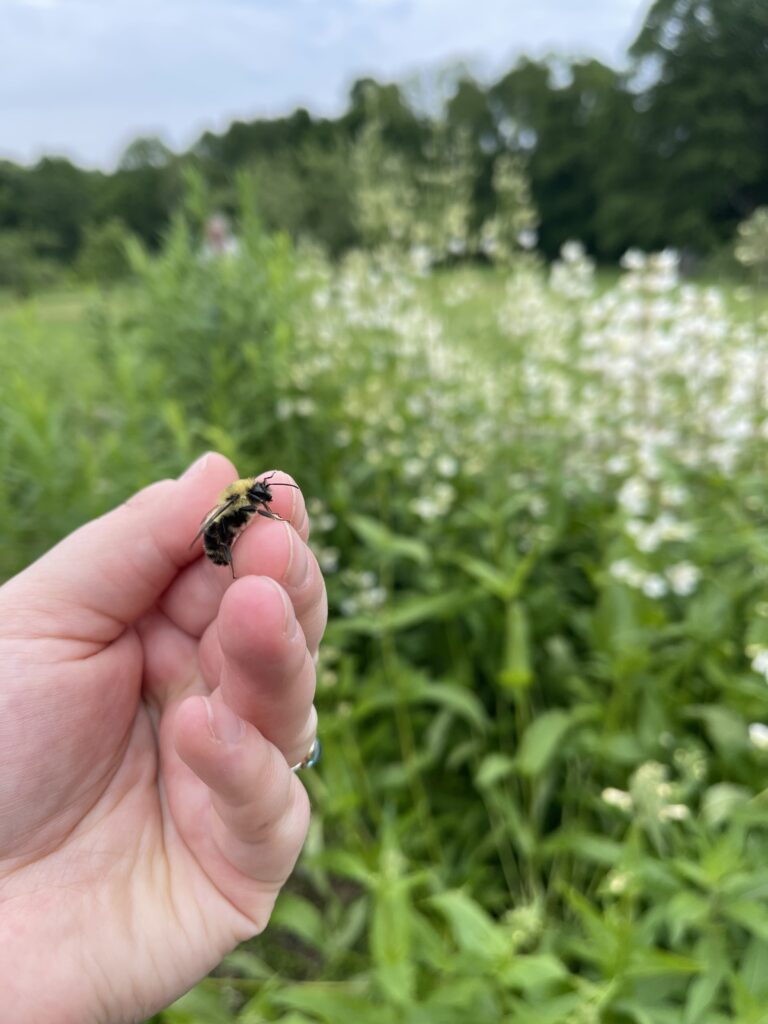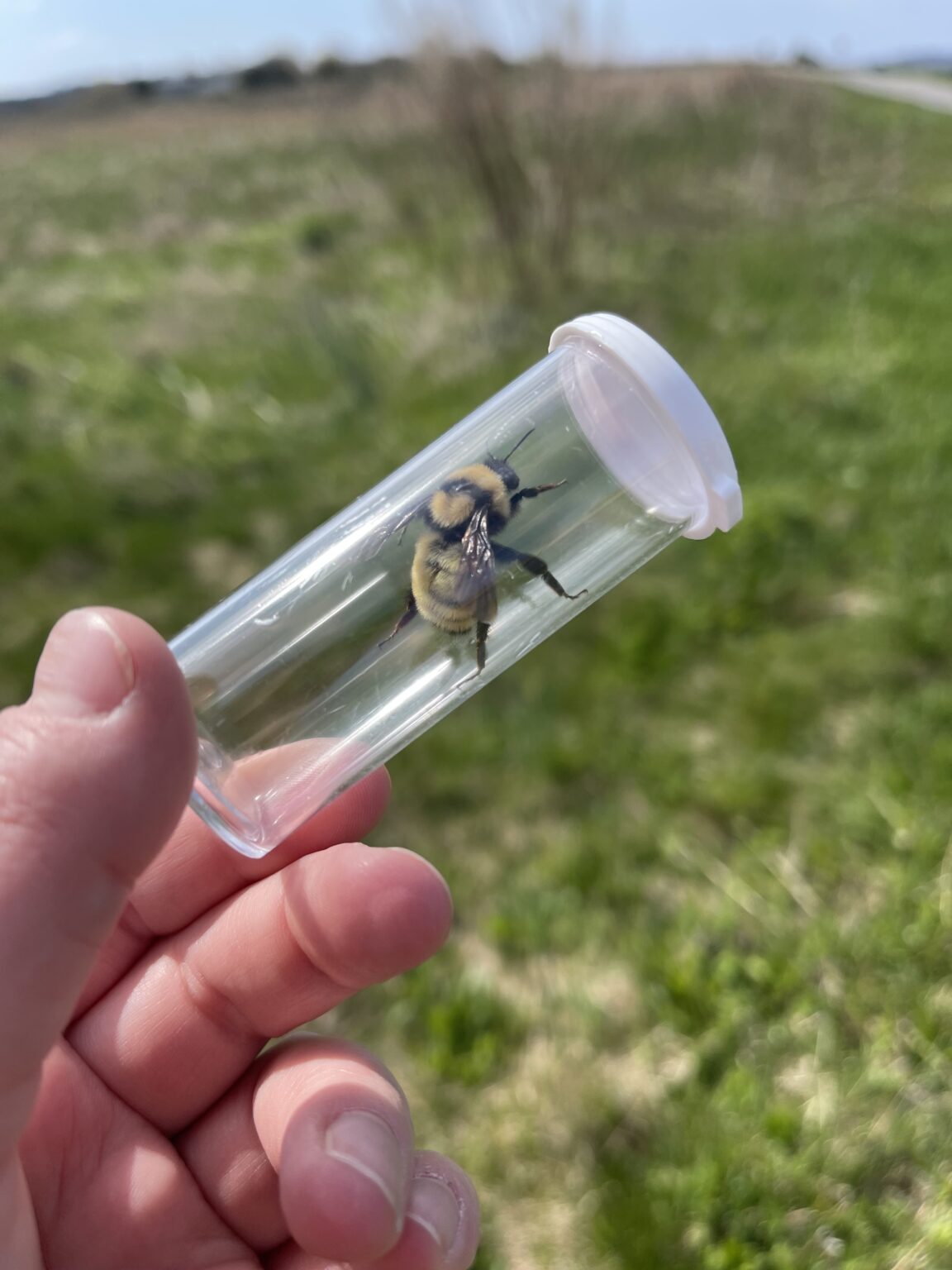Volunteers sought for 2023 study beginning in April
By Emily Olsen / ecoRI News contributor
The brilliant blue morning sky was made more vibrant by the contrasting field of goldenrod in the Great Swamp Management Area where Katie Burns stood. Alone in the cacophony of insect song, she quietly let her eyes adjust to the unique movements of the different pollinators around her before spotting a particular flight pattern. She swept her net through a swath of goldenrod, catching a bumblebee, and crooned to the insect as if it were a puppy as she coaxed it into a specimen jar and pointed out its identifying characteristics.
“One of the ways I can tell this one is a male is because he has
a little mustache,” she said. “See?” And he did, indeed, have a little mustache
that matched the earthy yellow of his stripes. She opened the jar and he flew
off to return to his breakfast, seemingly unaffected by his brief capture.
That bumblebee was an unwitting volunteer for the Rhode Island Bumblebee Survey (RIBS), a project led and developed by Burns. The atlas, backed by the Rhode Island Department of Environmental Management (DEM), Burns’ employer, will provide entomologists with baseline data.
It will inventory the bee, butterfly, and hoverfly species that currently live in Rhode Island, assess what resources are important to them, and pinpoint their preferred habitats so that scientists can track population declines and protect pollinators’ chosen dwellings.
 |
| A confusing bumblebee, Bombus perplexus, visits anise hyssop. (Rachael Bonoan) |
There are an estimated 250 species of bee in Rhode Island, and
Burns is starting her project focusing on one genus in the bee family: the
bumblebee.
“Historically, there were 11 species of bumblebee in Rhode
Island,” Burns said. “But currently, we can only find six.”
A combination of factors affected the other five. Some of the
southernmost populations vanished as climate change made Rhode Island less
habitable. Others struggle because of a lack of food sources.
“Bees we see disappearing are closely co-evolved with a flower
species,” Burns said. “Their relationship is like that of puzzle pieces. And
because they have such a specific niche, loss of resources can really affect
them.”
She’s curious to see if this research will find the missing
species in tiny pockets of the state. “Maybe they’ve found their niche on Block
Island,” she said. “But we have to know who’s out there before we can help
them.”
To gather data for the survey, Burns is relying on a group of
volunteer community scientists — members of the public who are not necessarily
professional scientists, but gather data for scientific studies. Each volunteer
is responsible for a 1-hectare region in one of the 5-kilometer-by-5-kilometer
squares making up an imaginary grid that overlays the state.
“It’s the same grid that the Rhode Island Breeding Bird Atlas used for their data collection,” Burns said, emphasizing her imitation was more than just flattery.
“Using their grid is a move toward
interspecies stewardship. If you have a healthy pollinator population, you’ll
get more plant material, more seeds, more fruit, more food for birds. It’ll be
interesting to see the food webs when these grids overlap.”
Volunteers are tasked with conducting a 45-minute survey in
their chosen hectare once a month. “It’s 45 minutes divided by the number of
people surveying the hectare,” Burns clarified. “So do it with a friend.” She
also advises volunteers to choose a spot they already feel a kinship to — a
place where they like to walk their dog or hike.
“Being part of a project like this helps people solidify their
sense of place. When we know our neighbors, our community is stronger. But
communities are made up of more than people,” Burns said. “They’re made up of
plants and foxes and bunnies and bees. By learning how to identify some of the
species in your backyard, it helps you feel connected.”
 |
| Katie Burns holds a male bumblebee, which is possible because male bumblebees don’t have stingers. (Courtesy photo) |
One of the 5km-by-5km grids lands on Providence College, and
biology professor Rachael Bonoan and a group of her students claimed it.
“During the school year, when I’m bogged down in teaching, it’s
nice to have an excuse to go outside once a month,” Bonoan said. “But the
biggest benefit was that this was an opportunity for me to teach my students
survey methods and bumblebee identification while contributing to a larger body
of research.”
Bonoan and her students were part of Burns’ pilot program, which
ended in October. The program had 14 active volunteers, and Burns said she
learned a lot through the experience. “My lovely volunteers, bless them, have
been very patient with me,” she said with a laugh.
“The biggest thing I learned is how important on-the-ground
training is,” Burns said. “I’ve been doing this work for 10 years, so it’s easy
for me to say, ‘Go catch bees!’ But the response is, ‘You want me to catch
something that can sting me and put it in a vial?’”
Community scientists have little to fear, however. Neither
Bonoan nor Burns had experience with the business end of a bumblebee during
their research.
Burns interrupted her description of the volunteer program to
talk to an insect and burst a couple of jewelweed pods, in a charming display
of her love for nature. “You don’t have to be an expert to enjoy nature,” she
said. “I just want to encourage curiosity in people.”
Burns believes it’s a mistake to rely solely on institutions and
agencies to protect the environment. “We’re not being set up for success,” she
said. “That’s why I like doing public engagement. And I try to make learning
experiences as joyful and accessible as possible.”
A self-professed “theater nerd” in school, she brings many of
the skills she learned on the stage to her work. “I’ve done comedy routines,
podcasts, Soapbox Science — where a group of women scientists would go into
public places, stand on soapboxes and just start talking — and PechaKucha,” she
said.
 |
| A bumblebee involuntarily participating in the R.I. Bumblebee Survey. It was released after examination. (Courtesy photo) |
At a late summer PechaKucha Night, a speaking event that highlights community members’ contributions to the state, Burns shared the stage with local artist, educator, and children’s entertainer Ricky Katowicz.
“I was so impressed with her style of presenting,” Katowicz
said. “She showed a lot of love for what she does.“ The pair teamed up to do a
bug-themed show, appropriately called “Bugs,” in October.
“Katie has a very commanding presence,” Katowicz said. “When she
talks, people listen.”
Burns has to make people listen because the things she says
about the path we are on are important.
“The most immediate repercussion of pollinator decline is a loss
of plant diversity, which may not be the end immediately,” she warned. “But if
we have fewer plants for pollinators and fewer pollinator species, if a disease
takes out a big species, like honeybees, we’d have a problem. Would there be
anything left to pollinate crops?”
In the fruit orchards of southwest China, heavy use of
pesticides has decimated local pollinator populations. Some farmers have to
hand-pollinate their fruit trees, using paintbrushes and little pots of pollen.
“It sounds like ‘Black Mirror’ stuff,” she said. “But it’s real and here and happening
now. It’s a glimpse of what the future could be without our pollinators.”
Burns has some advice for those who want to help steer us onto a
new path. Mow less. Reduce pesticide use. Plant native food species. Plant
native wildflowers. Turn off outdoor lights at night so moths and beetles don’t
get disoriented.
“Embrace a messier lifestyle,” said Burns, describing the winter
yards most attractive to pollinators. “If you’re really brave, leave all your
fall leaves where they landed. Hollow plant stems and leaf litter provide a
perfect winter habitat for dormant pollinators.”
It’s an incredible exercise of imagination to look at a dead
winter field and picture how much life exists there — the butterfly larvae
hiding in the skeletons of summer plants and tiny creatures tucked under a
blanket of leaves.
“These miniature worlds that surround us so often go unnoticed,
but once you see them you can’t look away,” Burns said. “These thriving
communities are just as fascinating as our own. And what a privilege it is to
recognize and be part of that world.”
Burns is seeking to recruit between 60 and 70 volunteer
community scientists to help her collect data for The Rhode Island Bumblebee
Survey in 2023. The data collection season will run from April to October. For
information on volunteering, go to https://forms.office.com/g/6XUxyP3rGc.
